History of the Boot Knife
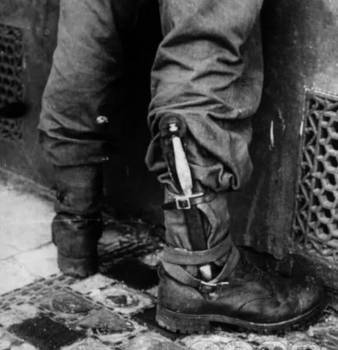
History is full of fascinating tales, and the story of the boot knife is no exception. From ancient times to the present day, the boot knife has held a prominent place in history as a versatile and useful tool for both professional and civilian use. Throughout the centuries, the boot knife has been used for a wide range of purposes, ranging from self-defense to everyday tasks such as hunting, fishing and more. In this blog post, we'll dive into the fascinating history of the boot knife, beginning with its humble origins in ancient times. We'll then explore its evolution up to the present day and the many innovative uses it has seen along the way. So, take off your boots, grab a mug of hot chocolate, and prepare to go on a journey into the captivating history of the boot knife!
Quick Insight into Key Points
Boot knives have a long history dating back to medieval times, when they were used primarily as a concealed weapon. In more recent times, boot knives are still used for self-defense, but also for hunting and everyday carry purposes.
What is a Boot Knife?
The origin of the boot knife is often debated, with some people attributing its early development to shepherds in ancient times and others claiming its inception arose from military use. During the 14th century, it is thought that shepherds in Spain and Italy developed small-bladed knives for their tools as a companion piece to their larger knives. These blades were often attached to their footwear or tucked into the pockets of a breeches garment to retain convenience when working with livestock.
By contrast, some suggest that the boot knife began with military personnel’s utilization during the American Revolutionary War in 1775. It has been noted by historians that soldiers fashioned crude weapons from salvaged materials to serve as backup pieces. Some of these homemade armaments featured double-edged blades which were mounted on the boots for concealed easy access should there not be enough time for retrieving a primary firearm or sword. The original intent was for close combat defense if needed and although these designs would eventually become refined over time, they set the precedent for today’s modern styles of boot knives.
No matter what its exact origins may be, it's no doubt that U.S Military personnel have helped shape today's versions of this tool. Contemporary designs are typically characterized as being an easily concealable double-sided blade no longer than five inches and featuring a handle guard carved directly into the guardsman's desired size of boot while still accommodating comfortable movement of the ankle and foot region when worn.
One thing is certain: the present day version of this convenient little knife has gone through various changes and improvements over years to deliver a reliable self protection tool for everyday citizens along with members of law enforcement and military service personnel. As we continue this journey through history, our next stop will take us from design and purpose to explore how centuries have shaped our current understanding of this unique weapon.
History of the Blade Design & Purpose
In addition to the boot knife's origins and the variations of design that still exists today, the history of blade design and purpose of the boot knife is equally compelling. The blade design is often a clip point, with a sharpened spine that is less than 3 inches in length. As its size has become increasingly more compact, so has its purpose. Boot knives are multi-faceted tools as they are used for self-defense, hunting and pocket use.
The debate between ancient weapon designers and modern day manufacturers centers around whether or not boot knives should be known as a weapon first or a tool second. Ancient warring nations developed the blades for close quarter combat which had much less emphasis on concealment when compared with modern age weapons such as handguns. In contrast modern manufacturers prioritize concealability thus emphasizing the practicality of boot knives for everyday use scenarios.
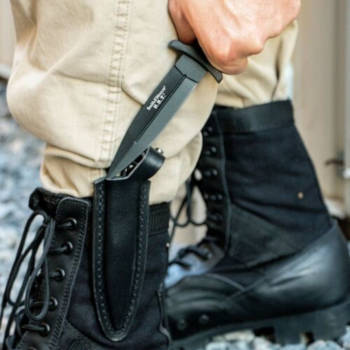
Proponents of ancient weapon makers argue that boot knives are designed as weapons first as historically, their designers intended them to be used to subdue an enemy during warfare or an animal during hunting expeditions. Furthermore, some can argue that by being easily concealed within one's boot, it provided an easy ever-ready attack solution when engaging in physical combat with others.
On the other side, those in favor of modern manufacturers argue that while this may have been true centuries ago, nowadays, boot knives are primarily thought of as versatile tools due to their small size, lightweight construction, and concealable nature. Taking this into account, it could be argued that it is no longer an easily accessible weapon leading one to conclude that in contemporary times they should simply be seen as just that - a tool.
Ultimately both sides can draw support from evidence in favor of their claims however, as society grows, develops, and evolves so too does its interpretations of tactics employed during wartime and hunting expeditions which leads to debates such as these occurring throughout history concerning devices like the boot knife. Having touched upon the boot knife's history and origins as well as its design and purpose, the next step within our research can take us onto a far more exciting path – its popularity among those who serve their country and practice sport hunting worldwide.
Popularity of the Boot Knife in Warfare & Hunting
The use of boot knives for warfare and hunting dates back further than one can imagine. Their small size, compact nature, and sharp blades make them highly useful as both a backup and a tool for quick access in dire situations. When it comes to warfare, they were renowned for being used as surprise weapons or to end duels swiftly. As far as hunting is concerned, they proved their worth by helping hunters secure their prized catches quickly and efficiently.
Due to their ubiquity throughout history, opinions of them regarding warfare and hunting have varied. Some find the blade too small and flimsy, while others respect its overall capabilities. Those who are critical of the design have argued that larger knives can be held better due to their weight and grip, versus boots knives' lighter weight, which can lead to slippage during heavy activity such as running or grappling with a target animal. They also point out that many boot knife designs do not have enough edge strength for heavy cutting tasks like skinning game animals.
Those who defend the blade praise it for its lightweight design and convenient accessibility on the body via belts or boots. The argument is that these qualities make it an ideal choice when traditional knives will not fit certain scenarios and demands, such as in tight quarters or situations where short periods of time exist to draw a weapon before being confronted. Thus making it easier to acquire during battle or while engaging with animals purely through convenience alone. Plus, they contend that high-quality boot knives are strong enough for more than just light slicing tasks such as filleting fish, even if they may struggle with tougher skinning jobs.
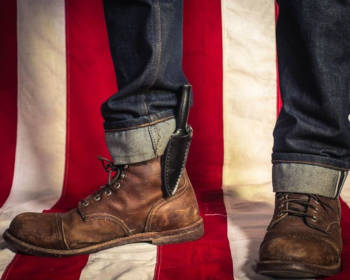
Despite the divergent opinions regarding boot knives, what remains true is that these handy blades continue to prove themselves capable of helping people effectively engage in both warring activities and hunting pursuits without fail. As we move forward, the ever-evolving utility of well-crafted designs will likely only increase this effectiveness - providing solutions to problems even further back in history couldn't ever solve. As evidenced by such utility, it's clear that there is still much potential explored with such tools, one that we look forward to uncovering more about in our next section when applying boot knives for uses during warring and hunting activities alike.
Uses of Boots Knives During Warring & Hunting
Throughout history, boot knives have been employed for various utilitarian warfare and hunting purposes. For example, many warriors used boot knives to skin animals and prepare food during camp out sessions. Landsknechts and other mounted infantry in the early 16th century employed so-called 'Dirk knives' that were designed for thrusting, cutting, and back slicing, which proved useful for engaging opponents unprepared for a close-quarter attack. Other historical uses for boot knives include protection against ambushes, marauders, and roaming bandits who roamed the vast wildernesses during those times.
Boot knives were also indispensable tools of choice amongst hunters, trappers, and survivalists who ventured into the wild; they often carried small daggers that could be concealed in various compartments of their boots or trousers. Such knives were able to help these individuals save energy and time as they often had to abridge or detach animal skins and fur when out in the wild. It is even known that some Native American tribes commonly used unique boot knives carved out of materials such as bones or rocks, further highlighting its role within the hunting culture worldwide.
Bearing this in mind, it would seem that there are clear benefits to carrying a knife at a person’s side – especially since it presents an opportunity for quick drawing that can deter potential attackers from attempting violent means before an engagement occurs. On the other hand, however, today, most countries have stringent laws concerning weapons possession, which can lead one to question whether this practice should still be employed today.
Be that as it may, what has become evident over the years is that boot knives have played a substantial part in hunting and warfare activities through time, primarily due to their robustness, portability and versatility; now more than ever, it is important for individuals engaging in such activities to understand the nature of their craft prior to using boot knives to ensure maximum safety upon wielding them. For this reason, it is pertinent to consider both material and utility factors when acquiring any type of foot wear implement or tool in order to ensure safe use with utmost accuracy when it comes time put them into practice.
Material & Utility Considerations
Material and utility considerations for boot knives are an important factor when purchasing a knife. Knives used for warring or hunting require blades that are durable, reliable, and able to endure harsh conditions. While some prefer stainless steel blades due to their resistance to rust and corrosion, others might opt for carbon steel as it holds a sharper edge for longer periods of time.
The type of handle also requires consideration when choosing a knife. Leather handles tend to be more secure and provide better grip than synthetic materials, however they can be challenging to maintain depending on the environment the knife is used in. Aluminum and G10 handles are great lightweight options that allow the user to manipulate the knife easy while providing excellent grip in wet situations. Yet many will argue that these materials are less stable than leather due to their potential to deform over time with extreme wear and tear.
Ultimately, finding the right balance between blade material and handle depends on each individual’s preferences and how the knife will be utilized. It is a good idea to research different types of blade materials available and what sort of handles are most ergonomically suited before finalizing a purchase decision, thus ensuring that you receive the best boot knife suited for your specific needs.
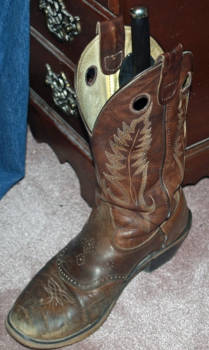
No matter what kind of knife you choose, selecting one made with quality craftsmanship is imperative as it could mean the difference between a lasting blade or a useless piece of scrap metal. With careful attention given to material and utility considerations, you can ensure that your boot knife meets all your requirements while remaining a dependable tool throughout its lifetime. Now we shall explore various types of materials used for blades and handles to help those seeking even more knowledge about this fascinating subject.
Various Types of Materials Used for Blades and Handles
The material of the blade and handle of a boot knife should be chosen carefully. On the one hand, metal is preferred for its strength and durability, and also because it can take a sharp edge for self-defense. Stainless steel blades are especially popular for outdoor activities because these blades resist rusting. Steel alloys like VG-10 are sometimes used because they provide enhanced corrosion resistance along with adequate toughness. On the other hand, synthetic materials like Delrin acetal resin or nylon 6 provide a lightweight option and come with corrosion resistance that’s comparable to stainless steel. Handles can range from natural materials such as wood, bone, and antler to modern materials like micarta and G10 fiberglass composites.
Today’s mix of manufacturing techniques makes it possible to find a good balance between performance and design considerations when looking for the right material for a boot knife. Whatever is chosen must be strong enough to provide confidence in the user but comfortable enough to speed deployment when needed.
No matter which route is taken, it is essential to ensure that the handle contains enough finger grooves to prevent slippage during use and that the blade shape is suitable for whatever task it performs. With so many options available now from modern technology, each person can select what fits their particular needs best among any potential materials for a blade and handle. With this flexibility in mind, let's turn our attention next to the advantages offered by owning a boot knife.
Essential Points
When selecting the material for a boot knife, metal is preferred for its strength and resistance to corrosion, whereas synthetic materials offer a lightweight option. Handles can be composed of natural or modern materials like wood, G10 fiberglass composites, or micarta. It is important to choose a handle with enough finger grooves to ensure secure use and the right blade shape for particular tasks. With all types of materials available, it is possible for each individual to select what best fits their own needs. The advantages of owning a boot knife are also discussed in this text.
Advantages Offered by Boot Knives
Boot knives have existed for centuries and have multiple advantages that have stood the test of time. Although boot knives are small, they offer an array of benefits to those who carry them. This section will examine the advantages offered by boot knives and discuss how these advantages make them powerful tools for self-defense and utility purposes.
One advantage of a boot knife is the ability to conceal it. Boot knives are usually designed to fit inside the wearer’s boot, making them easily accessible while remaining hidden in plain sight. This allows you to be prepared in case of a dangerous situation while not alerting others to the fact that you are armed.
Furthermore, boot knives can be very versatile tools when it comes to self-defense or utility purposes. The slim profile of a traditional fixed-blade boot knife keeps its weight down and makes it easy to grip in either hand if necessary for self defense. A fixed blade design also offers the strength and dependability needed for tough tasks like prying or cutting open boxes. Many designs feature secondary edges on the handle which can serve as a glass breaker and can also provide further utility such as a wire stripper, a pocket clip, or even a bottle opener.
Finally, due to their small size and relatively inexpensive materials used for blades and handles, boot knives tend to be fairly affordable compared to other folding knives or full-sized fixed-blades. This cost effectiveness makes boot knives ideal for those who may not want or need an expensive knife but still want the confidence that comes with having one always at hand while in public.
Overall, there are many advantages associated with carrying a boot knife over other forms of self-defense weapons and tools. Their small size allows them to remain easily concealable yet still offer convenient access when needed. Plus, their versatility in both self-defense applications and general utility use cannot be overstated. Finally, their affordability and availability make them much more approachable than similarly sized folding or larger fixed-blade designs, making them ideal for anyone looking for an effective yet economical self-defense tool.
Responses to Common Questions with Detailed Explanations
Are boot knives legal in all countries?
The legality of boot knives varies from country to country. In countries such as the United States, boot knives are legal in most states as long as they meet state regulations regarding blade lengths and other restrictions. However, countries like the UK have more stringent regulations regarding owning and carrying weapons, so it is illegal to carry a boot knife without permission in many areas. Additionally, certain countries, particularly those with strict gun laws, may include boot knives in their banned weapon lists and make them illegal to own or carry. Ultimately, the legality of owning and carrying boot knives varies widely by region.
Are there any particularly famous boot knives in history?
The boot knife has a long, interesting history throughout various cultures. Although it has not typically been considered a prestigious or glamorous weapon throughout the ages, it has made sporadic appearances in literature and folklore.
One of the most famous boot knives appears in the Arthurian legend of Excalibur. According to the story, after pulling the sword from the stone, King Arthur used a "merlin" to sheath and secure the blade to his side, keeping it hidden from plain sight. This merlin is believed to have been a unique version of a traditional dagger or boot knife.
Other than this example in folklore, other examples of famous boot knives mainly appear in modern times as they are commonly worn as practical tools by police officers and military personnel.
What was the original purpose of boot knives?
The original purpose of boot knives was simple: they were used as weapons. Boot knives have been found in archaeological sites dating back to ancient times and were primarily designed for one-on-one combat. In the Middle Ages, knights and foot soldiers often strapped short, sharp daggers to their calves for easy access during battle. Similarly, pirates and buccaneers often carried curved blade knives tucked into their boots for quick, stealthy attacks. The term "boot knife" was first coined in the 19th century when cowboys needed a versatile weapon that could be easily concealed beneath the boot shaft. It has since evolved in both style and purpose; today’s boot knives may be used for self-defense or various outdoor activities like hunting or fishing.
How has the design evolved over time?
The design of boot knives has evolved over time in order to suit changing needs and preferences. Initially, boot knives were dagger-like implements with simple pommels. Over time, however, variations in size, shape, and quality of materials used became more common. New features such as pocket clips, saw teeth, sheaths with integrated sharpening stones, and even locking mechanisms were added to serve various purposes.
As demand for better performance and longer blade life increased, manufacturers began experimenting with different blade alloys like stainless steel, which maintained their sharpness longer, as well as alternative handle materials like rubber and composite plastics, which provided better grip even in wet environments. In addition, developments in folding knife technology allowed knife designers to create folding versions of boot knives which made them easier to carry.
All of these changes have resulted in a much wider range of boot knives available today that are tailored for specific applications than ever before.
How are boot knives used today?
Boot knives are still used today for a variety of purposes, many of which are related to self-defense. Some people carry a boot knife as part of their everyday carry (EDC) while others may be trained in martial arts and use it as a tool for sparring and practice. Boot knives can also be used as a backup weapon in certain situations, such as if an individual is being attacked or threatened by someone carrying a large blade. Additionally, they can make great tools for fishing, hunting, and various outdoor tasks due to their small size and portability. Lastly, some people carry boot knives simply as a form of expression or style, often choosing attractive models with custom handles.
Add your comment now!
Post Comment
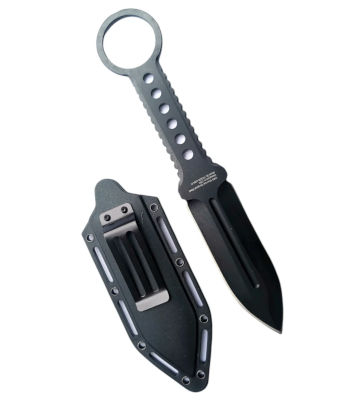 Double Edge Boot Knife
Double Edge Boot Knife


